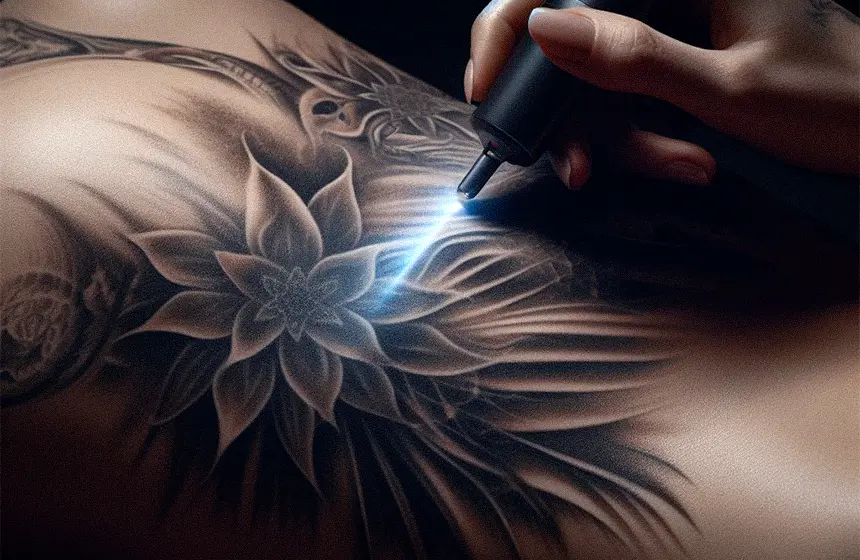How Much Does It Cost to Remove a Tattoo?
I’m no stranger to tattoo regret and the pricey quest for removal.
In this guide, we’ll explore the actual cost of erasing that unwanted ink. We’ll examine factors like laser types, tattoo size, and colour influencing the price tag. We’ll also touch on the extra costs that can surprise you.
Table of Contents
Key Takeaways
- The cost of tattoo removal can range from $500 to $2,000 per session, depending on factors such as the type of laser used, the size and colour of the tattoo, and the expertise of the specialist.
- The process of tattoo removal involves the use of lasers that cause the ink to explode into tiny particles, which are then removed by the body’s lymphatic system. After each session, a scab may form, and proper aftercare is essential.
- The duration of tattoo removal depends on the type of laser used and the individual’s response to the treatment. Q-switched Nd: Yag lasers may require 10-15 treatments, while picosecond lasers can achieve results in 5-7 treatments.
- It is crucial to choose a reputable and experienced dermatologist or tattoo removal specialist who specializes in the colour of your tattoo. Consultation with a professional is vital to understand the risks, side effects, and limitations of tattoo removal.
Understanding Tattoo Removal Costs
When considering tattoo removal, it’s essential to understand that the cost can significantly vary, ranging from $500 to $2,000 per session. This price fluctuation depends on numerous factors – the type of laser used, the size and colour of your tattoo, and the time it takes to remove it. The more complex and time-consuming the process, the pricier it tends to be.
The location and the expertise of the dermatologist or tattoo removal specialist can significantly impact the cost. You should also budget for consultation fees and aftercare products. It’s crucial to remember that tattoo removal is often a series of treatments rather than a one-off expense, and these costs can quickly add up.
The Process of Tattoo Removal

Understanding the tattoo removal process is as important as knowing the costs involved.
The type of laser used and its efficiency play a significant role in the removal process, impacting the number of sessions required and, ultimately, the cost. The aftercare and recovery period, along with individual body responses, are other vital factors influencing the overall experience and effectiveness of tattoo removal.
Laser Type and Efficiency
In the process of tattoo removal, the type of laser used plays a crucial role in the efficiency and cost of the procedure. There are primarily two types of lasers used:
-
Q-switched lasers: These have been around for a while and do an excellent job removing black and dark-coloured tattoos. However, they are not as effective on light-coloured or intricate designs.
- Efficiency: Moderate
- Cost: Lower
-
Picosecond lasers: These are the latest innovations in tattoo removal. They deliver energy in a trillionth of a second, effectively shattering the tattoo ink into tiny particles. This makes them highly efficient, even with stubborn colours and intricate designs.
- Efficiency: High
- Cost: Higher
As you can see, the laser type directly impacts the efficiency and cost of tattoo removal.
Aftercare and Recovery
Following up on the tattoo removal procedure, it’s crucial to focus on aftercare and recovery to ensure I get the best results.
The process is still ongoing once the laser session ends. The majority of the healing happens at home. I must keep the treated area clean and moisturized, using a healing ointment like Aquaphor or Vaseline, and avoid sun exposure. It’s also important to be patient. The lymphatic system gradually removes shattered ink particles over several weeks. During this time, I could experience redness, swelling, and even blistering. However, these are standard parts of the healing process. Proper aftercare, combined with the right mindset, ensures an optimal tattoo removal process.
Aftercare and Additional Costs
When considering tattoo removal, it’s essential to factor in not only the cost of the procedure itself but also the expenses related to aftercare and potential additional fees.
- Aftercare Costs
- You’ll need to invest in quality aftercare products such as antibiotic ointments and gentle cleansers to aid in the healing process.
- Regular follow-up appointments may also be necessary to monitor the healing process and adjust your treatment plan.
- Potential Additional Fees
- Be aware that some clinics may charge consultation fees or require a deposit.
If your tattoo is particularly large or complex, multiple sessions may be required, each incurring cost.
Determining the Duration of Removal
The duration of tattoo removal is influenced heavily by factors such as the type of laser used and the tattoo’s colour. Typically, Q-switched Nd: Yag lasers require more sessions than picosecond lasers due to their different efficiencies in breaking down tattoo particles. Using the wrong laser for specific colours can extend the removal process and may only partially eradicate the ink.
Laser Type’s Impact
In my experience, the type of laser used has a significant impact on the duration of the tattoo removal process. Different lasers have varying effectiveness levels, significantly influencing the number of sessions needed for complete removal.
- Q-switched Nd: YAG lasers
- Generally, they require between 10-15 sessions.
- They’re efficient but not as fast as other options.
- Picosecond lasers
- Usually, they achieve results in 5-7 treatments.
- They break up tattoo particles into smaller pieces, making removal quicker.
Colour and Removal Time
As a tattoo removal specialist, I’ve noticed that a tattoo’s colour significantly affects the duration and complexity of the removal process. Dark colours like black and blue absorb all laser wavelengths, making them easier to remove.
Lighter colours, such as green, orange, and predominantly yellow and white, are more challenging because they only absorb specific wavelengths. This means that we need to use particular lasers to target these colours effectively.
A common misconception is that all colours can be removed in the same timeframe. However, the reality is that the removal process could take longer if your tattoo has many different colours. It’s crucial to consult with a professional who can provide a realistic timeline for your specific tattoo removal.
Incorrect Laser Consequences
Choosing the wrong type of laser for your tattoo removal can not only prolong the process but also increase the cost significantly. This mistake might lead to a less effective treatment, requiring more sessions and thus increasing the price.
Effectiveness of Different Lasers
Understanding the effectiveness of different lasers is crucial when considering the cost and duration of tattoo removal. Not all lasers are created equal, and the choice of laser can significantly affect the removal process. Q-switched lasers, for instance, often require more sessions than picosecond lasers, which use innovative technology to shatter ink particles more effectively.
The tattoo’s colour also plays a role, with certain hues needing specialized lasers for complete elimination. Using the wrong laser prolongs the treatment and leaves some colours behind. So, it’s not just about the cost but also the laser’s effectiveness. I’ve learned that it’s about finding a balance. Innovation, professional advice, and tailored treatment plans are essential for efficient and effective tattoo removal.
Colour Considerations in Tattoo Removal
While I’m mindful of the importance of laser types in tattoo removal, I can’t ignore how the colour of my tattoo significantly impacts the process and cost. The hues used in my skin art play a pivotal role in the efficiency of the removal process and, consequently, the overall expense.
- Black and dark green inks are more receptive to laser treatment and, thus, more accessible to eliminate.
- This might mean fewer sessions and fewer costs.
- Contrarily, colours like blue, yellow, and fluorescent shades can be more stubborn.
- This could require more sessions, advanced laser technologies, and expense.
Understanding these colour considerations provides a clearer picture of the process. It helps set realistic expectations about the time, effort, and money required for successful tattoo removal.
Choosing the Right Tattoo Removal Service
Given the complexities I’ve learned about tattoo colours and removal processes, it’s clear that I’ll need to carefully select the exemplary tattoo removal service for my specific needs. Key factors to the clinic’s expertise, the type of equipment they use.
Most importantly, I must ensure that the dermatologist or tattoo removal specialist is experienced and reputable. This isn’t a decision to be taken lightly. After all, I’m investing not only my money but also my skin’s health in this process. Therefore, a thorough consultation before the treatment is crucial.
Risks and Limitations of Tattoo Removal
Despite the advancements in tattoo removal technology, there are still inherent risks and potential limitations I’ll need to consider. The procedure isn’t completely free of side effects.
-
Risks:
- Potential skin damage: Lasers can sometimes lead to burns, changes in skin texture, or even scarring.
- Infections: Improper aftercare can lead to infections, delaying the healing process.
-
Limitations:
- Incomplete removal: Some tattoos, particularly those with specific colours or high ink density, may not be removable.
- Multiple sessions: The removal process can take numerous sessions, depending on the size, colour, and location of the tattoo, which can add to the overall cost and time commitment.
It’s crucial to weigh these factors against the desire for tattoo removal.
Dealing With Tattoo Regret and Healing Process
Facing the reality of my tattoo regret, it’s also crucial I fully understand the healing process following each removal session, which can be pretty meticulous and demanding.
| Phase | What to Expect | Care Needed |
|---|---|---|
| Immediate Aftermath | Redness, Swelling, Minor Bleeding | Apply ice, elevate the area |
| Healing | Formation of Scab, Itchiness | Apply prescribed ointment, avoid scratching |
| Long-term Healing | Lightening of Tattoo, Skin Texture Changes | Moisturize, sun protection |
It’s essential to follow all aftercare instructions to avoid complications and ensure optimal results. A critical part of dealing with tattoo regret is patience. Remember, laser tattoo removal is a process, not an immediate solution. But with time, dedication, and a professional guiding you through every step, you can overcome tattoo regret and move forward.
Frequently Asked Questions
-
Does Health Insurance Cover the Cost of Tattoo Removal?
Typically, health insurance doesn’t cover tattoo removal as it’s considered a cosmetic procedure, not a medical necessity. But it’s always worth checking with your specific provider for their policy.
-
Can All Tattoos, Regardless of Color or Age, Be Completely Removed?
Not all tattoos can be removed entirely due to factors like colour and age. Some colours are more complex to remove, and older tattoos may have penetrated more profoundly, making complete removal more challenging.
-
Can Tattoo Removal Cause Scarring or Skin Discoloration?
Yes, tattoo removal can cause scarring or skin discolouration. It’s crucial to follow aftercare instructions to minimize these risks. Choosing an experienced professional can also ensure the best possible outcome.
-
What Factors Can Influence the Effectiveness of Tattoo Removal?
Several factors can influence tattoo removal’s effectiveness. These include the type and colour of ink used, the depth of the tattoo, the individual’s skin type, and the type of laser treatment utilized.
Conclusion
In sum, tattoo removal is costly and complex, influenced by factors like laser type, tattoo size, colour, and the professional’s expertise. It’s a decision not to be taken lightly, with costs ranging from $500 to $2,000 per session. But if you’re grappling with tattoo regret, like I once did, it’s a journey worth considering. Do thorough research, understand the implications, and choose the exemplary service. It’s a step towards healing and freeing yourself from regret.





